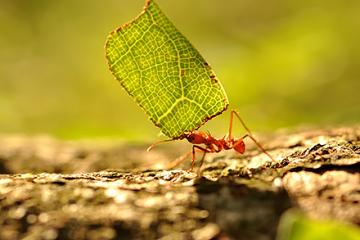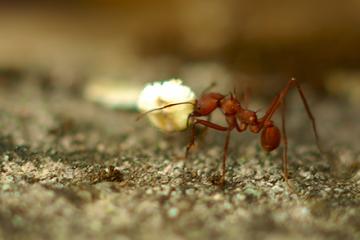Internal Compass Helps Ants Navigate Long Distances

A leaf-cutter ant worker returning to its nest with a leaf. (Photo courtesy of Getty Images)
You may think you have an “internal compass,” but to match the navigational expertise of ants, you would have to trek hundreds of miles and still find your way home. Researchers have found that types of fish, migratory birds, bats, and insects, including leaf-cutter ants, can sense magnetic fields associated with Earth, similar to an internal magnetic compass that allows them to travel long distances without getting lost. This ability is known as "magnetoreception." It gives certain insects a directional reference to identify precisely where home (or colony) is relative to their position.
ARS scientists at the Northern Plains Agricultural Research Laboratory in Sidney, MT, are working with collaborators in South America to study magnetic senses in leaf-cutter ants, a major cultural pest for tropical and subtropical crops. Farmers in the southern United States and around the New World spend millions of dollars a year trying to control this insect.
Researchers believe leaf-cutter ants’ behavior is similar to humans using a regular compass for navigation coordinates. However, it's more than sensing polar magnetic fields. These insects can navigate their path under any circumstance, integrating their internal compass with other factors like sun orientation, skylight polarization patterns, and landmarks. And some insects are believed to have a tridimensional sensor that recognizes angle inclinations in Earth’s magnetic fields (an internal inclination compass).

A leaf-cutter ant worker returning to its nest with a barley flake used for training. (Photo by A J Riveros, Universidad del Rosario, Bogotá)
“Leaf-cutter ants are known to walk hundreds of yards, even climbing trees, to collect leaves,” said ARS research ecologist Robert Srygley. “Still, they can identify their way home to bring back the plant materials they use to harvest a fungus that provides their primary source of food. We observed that when this insect is dislodged from their trail, they orient homeward using a magnetic compass. Exactly how the compass works remains a mystery, but we know that contact with soil is important.” This study was published in Behavioral Ecology and Sociobiology.
Srygley seeks to use his knowledge in the field from past studies on magnetic compass in insects and study on migratory and non-migratory neotropical Lepidoptera to explain the complexity of this behavior.
"It is important to learn the ants’ spatial behaviors. Leaf-cutter ants can cause devastation in nearby crops and damage farmlands, decreasing farmers' annual crop yield and becoming a significant economic problem.," expressed Srygley. “These insights can help predict the movement of this insect between crop patches, to interrupt it, and improve control." - By Maribel Alonso, ARS Office of Communications.

